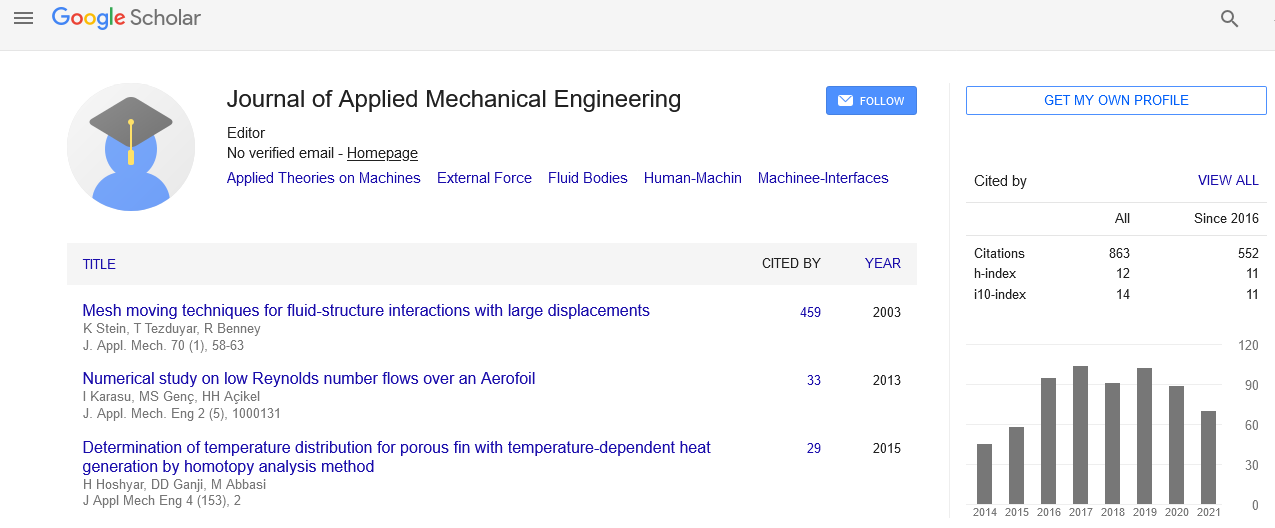Indexed In
- Genamics JournalSeek
- JournalTOCs
- CiteFactor
- RefSeek
- Hamdard University
- EBSCO A-Z
- OCLC- WorldCat
- Publons
- Google Scholar
Useful Links
Share This Page
Journal Flyer

Open Access Journals
- Agri and Aquaculture
- Biochemistry
- Bioinformatics & Systems Biology
- Business & Management
- Chemistry
- Clinical Sciences
- Engineering
- Food & Nutrition
- General Science
- Genetics & Molecular Biology
- Immunology & Microbiology
- Medical Sciences
- Neuroscience & Psychology
- Nursing & Health Care
- Pharmaceutical Sciences
Perspective - (2023) Volume 12, Issue 1
Influence of Couple Stress Lubrication on Working Principle of Bearings
Harla Grace*Received: 02-Jan-2023, Manuscript No. JAME-23-19985; Editor assigned: 04-Jan-2023, Pre QC No. JAME-23-19985 (PQ); Reviewed: 18-Jan-2023, QC No. JAME-23-19985; Revised: 23-Jan-2023, Manuscript No. JAME-23-19985 (R); Published: 03-Feb-2023, DOI: 10.35248/2168-9873.23.12.457
Description
The thrust on higher productivity in industries necessitates to run the heavy machinery at very high speed. In various industrial applications viz. power plant, crusher, turbine etc. fluid film journal bearings are widely used to support heavy load at high speed. For heavier load and high-speed applications, the functioning of the bearings become quite vital. Therefore, it becomes essential to pay attention on the research and development of this machine element of vital significance. In recent years, a remarkable technological advancement in the design of fluid film bearing system has been witnessed to make its operation more reliable, robust and efficient.
In journal bearing system, surface of the journal and bearing are separated by a pressurized oil film of lubricant. The primary function of fluid film in a journal bearing system is to withstand against the external load and to avoid contact between rotor and stator. The fluid film pressure may be generated either inducing the relative motion between the surfaces or external pressure. The bearing using pressure generation mechanism based on relative motion is known as self-acting (hydrodynamic) bearings and second one is known as externally-pressurized (hydrostatic/ hybrid) journal bearings.
In hydrodynamic journal bearings, the fluid film pressure is generated in the bearing clearance space due to journal rotation in order to support the external load and separate completely the sliding surfaces. Due to journal's rotation, the pressure wave in the lubrication film is created by hydrodynamic action. The fluid film acts as a viscous wedge and generates high pressure and load-carrying capacity. These bearings have the great advantage that they are essentially simple and thus stable and inexpensive, besides having lower frictional drag and therefore lower power loss.
Hydrostatic bearing's basic mechanism is to provide a supply lubricant under pressure at a number of locations in the bearing area to balance the external load. Therefore, the hydrostatic bearings refer to a configuration where an external high-pressure pump generates the pressure in the fluid film. The high-pressure lubricant is pumped through the high-pressure tubing into the bearing recesses from an external pump. In the bearing recesses the fluid under high pressure bears the load and separates the sliding surfaces, thus avoiding excessive friction and wear.
In order to maintain the continuity of lubricant flow in the bearing, a flow control device is required in each recess to regulate the recess pressure which needs to be adjusted to accommodate variations in the load applied to the bearing film and thus flow restrictors are used to regulate the recessed pressure. The geometrical shape of flow restrictors considerably affects the bearing stiffness, pumping strength, supply pressure and flow of lubricant.
Conclusion
A flow restrictor is essential to make sure that the pressure drop between the supply manifold and the pad recesses is maintained to ensure that the pressure requirements in any given pad never exceed the supply pressure. Mainly two types of flow control devices used in a hydrostatic/hybrid journal bearing; one is fixed flow type and second is variable-flow type (viz. Membrane type). The variable-flow restrictor offers higher stiffer bearing mechanism, but costlier as compared to fixed-flow restrictors. These types of bearings are commonly used in many engineering applications such as high-speed turbo machines, machine tool spindles, precision grinding spindles, reactor coolant pumps, liquid rocket engines, research equipment etc. In addition, these kinds of fluid film bearings are commonly used for their long-life expectancies, low frictional power losses and versatile dynamic behaviour.
Citation: Grace H (2023) Influence of Couple Stress Lubrication on Working Principle of Bearings. J Appl Mech Eng. 12:457.
Copyright: © 2023 Grace H. This is an open-access article distributed under the terms of the Creative Commons Attribution License, which permits unrestricted use, distribution, and reproduction in any medium, provided the original author and source are credited.

